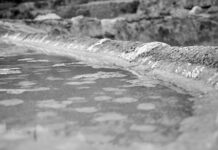GeoMed2011 – 4th International Conference on Medical Geology – Italy
In this era when many bacteria have developed antibiotic resistance, and may produce more harmful toxins as a defense mechanism (e.g. Shiga-toxin), investigation of natural alternative antibacterials is of paramount importance. Natural clays have been used for healing since the earliest recorded history, but their medicinal properties have largely not been scientifically recognized.
Medicinal and therapeutic uses of clays have been documented based on the extraordinary absorptive/adsorptive properties of clay minerals and the health benefits recognized in aiding digestive processes or cleansing and protecting the skin. Kaolins adhere to the gastrointestinal mucosa as a protective coating, or absorb and rid the body of dissolved toxins, bacteria, and viruses. While the ability to absorb water and organic matter is a common attribute of many smectites, certain clays were identified that do not physically adhere to bacteria, but are antibacterial against a broad spectrum of human pathogens including antibiotic resistant strains. French green clays (rich in Fe-smectite) were used clinically for healing Buruli ulcer, a necrotizing fasciitis (‘flesh-eating’ infection) caused by Mycobacterium ulcerans.
Clinical work by Line Brunet de Courssou (Williams et al., 2004) highlighted the potential medicinal use for natural clays. Since then other clay deposits have been identified containing minerals that are bactericidal. These clays are important because they may reveal an alternative antibacterial mechanism to those commonly employed by antibiotics, leading to an economical treatment for skin infections, especially in global areas with limited hospitals and medical resources.
Analysis of the chemical interaction occurring at the clay mineral – bacterial interface is being explored and will be pertinent in understanding the mechanism by which the clay minerals can inhibit bacterial growth. Initial investigations show that various natural clays can have no effect on microbial growth, enhance microbial growth or completely inhibit growth. Therefore, it is important to identify the common components of natural clays that exhibit an antibacterial effect.
A comparison was made of the depositional environments, mineralogies and chemistries of several antibacterial clays that kill a broad spectrum of human pathogens. Results suggest that bactericide results from a chemical reaction, which may disrupt an essential physiological function of the bacteria.
Common properties of the antibacterial clays include:
(1) Natural antibacterial clays contain nano-scale (<200 nm) illite-smectite crystals, which provide an extensive and reactive surface for biogeochemical interactions. (2) Each clay contains minerals with reduced Fe and other transition metals that may play a role in the antibacterial process by producing reactive oxygen or nitrogen or sulfur species that potentially degrade organic components critical to cell survival. (3) The antibacterial agent is soluble at extreme pH (<4 or >10) and low oxidation state. (4) There is no physical attraction of the clay to bacteria, and without water there is no antibacterial effect. Therefore the antibacterial mechanism involves solution components and chemical reactions affecting the cell wall or metabolic functions. GeoMed2011 – 4th International Conference on Medical Geology – Italy IV (5) Aqueous clay leachates are antibacterial initially, but lose their effect on bacteria as the solution becomes oxidized. This points to an important role of the clay in buffering the solution chemistry to conditions that promote solubility of transition metals involved in the antibacterial reaction.
Keywords: clays, bacteria, Medical Geology









![Effect of sea mud compresses from Messolonghi lagoon as a treatment for cellulite [Experimental study]](https://saltandmud.gr/wp-content/uploads/2021/08/unnamed-218x150.png)










